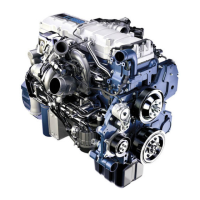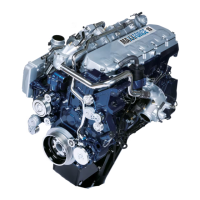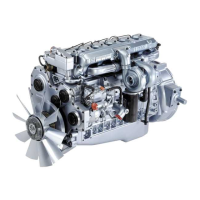114 4 ENGINE SYMPTOMS DIAGNOSTICS
Excessive Fuel Consumption
Symptom
Occasionally, it may be noticed that more fuel is
required to perform the same task as before.
Cause
Operator effect
• Inaccurate record keeping or tank fillin g
• Winter blend or No. 1 fuel
Application effect
• Heavy loading Gross Vehicle Weight (GVW)
• Low rear axle ratio
• Large frontal area
• Accessory usage (Power Takeoff, etc.)
• Additional equipment drawing fuel from vehicle
fuel tanks
• Extended idle applications
• Tire size, tire condition, air pressure
Chassis effect
• Brake drag
• Cooling fan clutch locked ON
• Transmission slippage/shifting
• Fuel tank plumbing or venting
• Intake or exhaust restriction
Engine effect
• Incorrect or failed thermostat
• Failed Variable G eometry Turbocharger (VGT)
operation
• Oil aeration
• Fuel system leaks
• Base engine performance loss
Procedure
1. Review operator records and fueling procedures.
Measurement errors are common. Fuel
consumption taken only from one tank of use
is susceptible to signific an t error b ecause of filling
procedures and vehicle application differences
during operation. Accurate fuel consumption
must be measured over time with a record of what
the vehicle was doing during the measurement
period.
2. Loss of fuel economy is normal if winter blend fuel
or No. 1 diesel fuel is being used.
3. Review vehicle specifications to determine if fuel
consumption is n ormal for type of application
and use of vehicle. (Compare consumption with
similar vehicles in the same application and Truck
Computer Analysis of Performance and Economy
(TCAPE) re port.
4. Do all tests on Performance Diagnostic form or in
Section 6 of this manual. These tests will verify
the operating condition of the following engine and
chassis systems:
• Intake system
• Exhaust system
• Fuel delivery and filtratio n
• High-pressure oil sy ste m
• Injector operation
• VGT operation
• Oil aeration
• Base engine condition
• Electronic control system condition
If all tests are passed, the engine is operating
normally.
EGES-270-1
Read all safety instructions in the "Safety Information" section of this manual before doing any procedures.
Follow all warnings, cautions, and notes.
© August 2008 Navistar, Inc.

